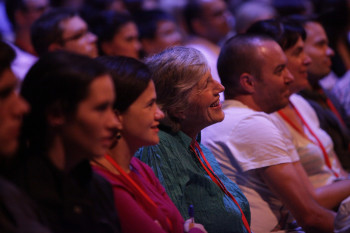As I mentioned in Part I, if you don’t feel comfortable using social media to develop “thought leadership,” as such, it might be more comfortable for you to think about developing “influencer engagement” instead. The shift from “all about me” to “all about them” – the industry thinkers and influencers – changes the expectation.
Far from tooting your own horn, the idea is that you are instead gaining a reputation for being someone to follow and learn from. Your reputation is built on the quality of what you share and which new influencers you introduce to others.
The Process of Engagement
So, how does this work? How might you go about identifying and engaging with your industry’s key online/social influencers in a way that AUTHENTICALLY builds your own profile in those conversations?
A few tips:
1. Start by asking yourself if any of your focus area’s key offline influencers are already on a particular social network and whether you can observe them having honest, productive (and even, dare we dream, fun…?) interactions.
Note: It is certainly possible that many offline influencers in your field are not using social media at all. My guess is that the majority of organizational cultures today just don’t (and may never) see the professional development point in spending time on Twitter, for example. So, you may be the first to forge boldly ahead (even on your own time) to make the case for its power.
2. If you find your identified influencers ARE using social media (even just a few) – do a cheer! Then, dig into the tags and keywords they are currently discussing (examples from my field would be #sustainability or #climateaction ). Check out who is sharing what, and observe the quality of the “conversations” in that keyword stream. Follow, engage and contribute.
Note: One way to see if your noted influencers are worth following is to see which of them posts a few times a week (at least) and also appears involved in conversations with others. For example, you may see him/her thanking or cheering others on versus the other, more common approach, of simply posting “here’s another link” and “here’s another” and “I’m speaking at this glamorous event.” More clues: take a look at who is following them (do you see other people you, too, highly regard?). And, consider whether the way these potential influencers engage on social media makes them seem like people you’d ultimately want to have conversations with, online and off. Can you see being able to contribute value and be acknowledged, etc?…
3. Once you’ve got your go-to influencer list (make it an actual easy-to-follow Twitter list ), “love ‘em up.” When you see great insight or information coming from anyone in that small group, share and share again.
Note: Early on, your advanced spotting and re-sharing of others’ work can lay an incredible foundation of goodwill. You are truly banking the love. To be clear, this “loving up” via a re-share of a link and/or value-add comment must be done with authenticity. Manufactured enthusiasm in tweets is uncomfortably obvious, and will do more harm than good.
4. Repeat the above steps. Culling and crafting your influencer list(s) will be a continual process. If all you do is very deliberately, hit “follow” and authentically share or connect with even a select number of folks, you’ll maintain a power-packed network and learning stream.
Note: Keep that primary list of influencers you follow as small as possible (I’d suggest no more than 25). It’s easier to then commit to monitoring their streams. A less time-intensive, more manageable process will result in more success for your influencer engagement strategy over the long run.
Create Human-Scale Expectations
Word to the wise: managing expectations is not optional when it comes to influencer engagement. It is absolutely necessary. You are a human and not a machine. So, get into your natural social media rhythm, which could well mean that you are only “on” every weekday for 20 minutes at around 10 am. People will see and note your pattern of involvement. . With that foundation, you will have set reasonable expectations that you can continue to meet over time.
As well, pay little attention to all the lists of “best practices” in social media. They are often more about consumer-facing situations, for one thing. But, more importantly, your stream of sharing and engaging is YOU! It should reflect an incredibly unique human being with a spouse and kids, and a fitness class you go to every Tuesday at noon… or whatever your life contains. The more that real people act real when “on,” and disengage from social media in a healthy way in order to be “off,” the more models of manageable (and powerful) social engagement behavior we’ll have. Potential followers will notice, learn from and respect your boundaries.
Build Engagement That Reflects Leadership
So, how does this sort of engagement get back to leadership? When you place yourself in the midst of thinkers who challenge and inspire you, you absolutely learn. But, it’s the sharing and connecting with others – thereby being a conduit of great thinking for your own followers in turn – that increases your industry visibility and profile.
As a value-sharing curator, you can’t help but attract more followers and get involved in deeper, more influential conversations.
And, that, looks good on you.
Special thanks to TEDxSydney for use of the image.





